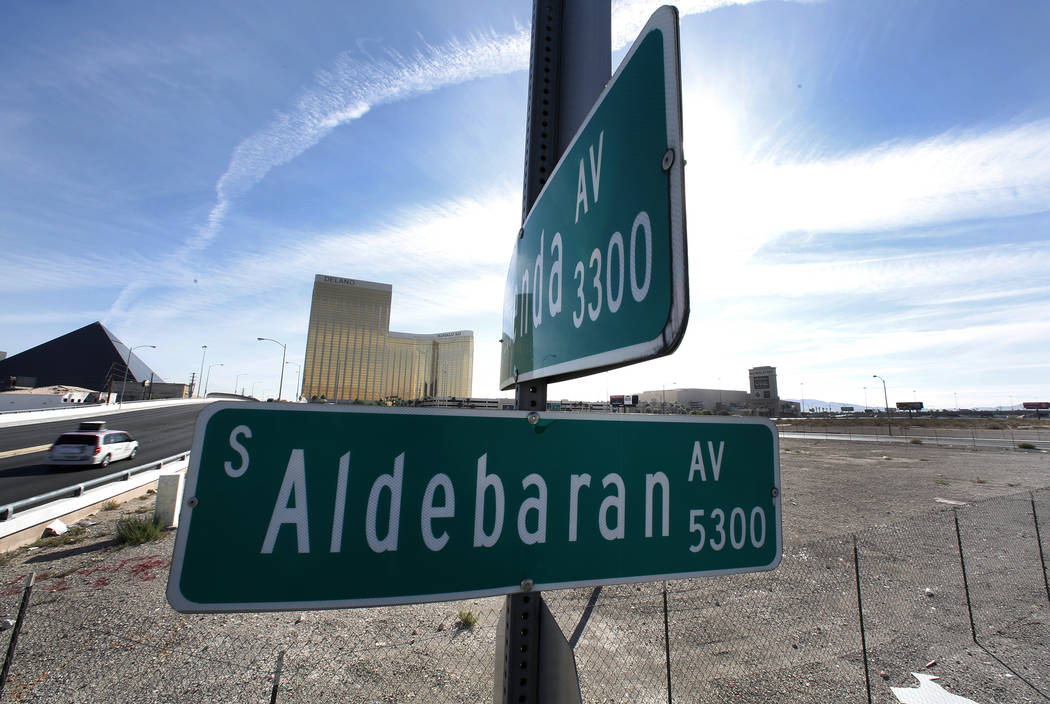Road at Raiders Stadium site in Las Vegas may be abandoned


Sometimes, it’s the little approvals that mean a lot when it comes to completing the long list of documents necessary for the Raiders to begin building that $1.9 billion, 65,000-seat Las Vegas stadium.
One of those little approvals occurs Wednesday — so routine that Clark County commissioners probably won’t even talk about it before giving their OK.
Commissioners will consider the abandonment of Aldebaran Avenue, a half-block road that runs from Dean Martin Drive to Hacienda Avenue on the northeast corner of the 63 acres planned for the stadium.
The matter is part of Wednesday’s consent agenda, a list of approvals that are mundane enough that they lack a cause for debate.
Pedestrian plaza
Aldeberan is a portion of right-of-way on the acreage purchased by the Raiders for $77.5 million in May. The team’s contractors have done some minor drilling on the property to prepare it for construction, but little more.
The northeast corner of the property would be the location of a pedestrian plaza at the main entrance to the domed stadium and abandonment of the street is necessary to carry that out.
The tiny piece of progress contrasts with the mountain of work still to be done — and set back by the cancellation of the Stadium Authority’s Oct. 12 board meeting.
Board Chairman Steve Hill scrapped the meeting, stating publicly that there was still work to be done on proposed documents leading to a final development agreement.
While no one will say it, the cancellation may have been more about respecting the need to cope with the Oct. 1 mass shootings that occurred less than a mile from the stadium site. The Stadium Authority board includes nine business people, including two casino industry executives, one from MGM Resorts International.
While the cancellation was necessary, it could set an already tight construction timeline back.
Done by February
Initially, the board had hoped to wrap up all agreements by October so that pre-construction work could begin in November.
Board members already have approved a measure preventing the authority from sunsetting on Tuesday one year after Gov. Brian Sandoval signed Senate Bill 1. The extension gives the authority another six months to wrap up agreements, although members say they now expect to be finished by February.
Of the checklist of items left, the most critical are development agreements with the authority and Clark County and those are dependent on other related pacts.
“One is the community benefit plan, which has been talked about by the Stadium Authority board and Steve Hill has indicated we’d be a part of the discussion and will be discussed on Nov. 9,” said Jeremy Aguero, principal of Las Vegas-based Applied Analysis, which serves as the authority’s staff.
“The other one that we’ve been spending quite a bit of time on is the UNLV joint-use agreement where there are issues that we’re continuing to work through in a productive manner,” he said.
Community benefits
The community benefits plan spells out how the Raiders would contribute philanthropically, contract with small businesses and provide jobs for local minority laborers.
Last month, the Raiders released a conceptual outline of their plan. Aguero said it’s not up to the authority board to negotiate the details.
“It does have the ability to say that they feel the community benefits plan that is being forwarded by the Raiders either meets the obligations of the law or does not meet the obligations of the law,” he said. “The community benefits plan has to exist but it does not have to be something that’s negotiated.”
The other big consideration on the table is the Raiders’ joint-use agreement with UNLV, since a key sales point for providing $750 million in public funds was approval was providing a place for the Rebel football team to play.
No sticking points
Aguero said there aren’t any sticking points in an agreement with UNLV, and it covers a broad number of topics that include access to the stadium, ticketing, use of luxury boxes, food and beverage contracts, stadium advertising, field markings and even the field surface itself.
“There are a broad number of business issues and legal issues that have to be worked out,” Aguero said.
Once an agreement is reached, it would have to go to the Nevada Board of Regents before it can be considered by the Stadium Authority. Regents have yet to set a date for a special meeting to consider that agreement.
Contact Richard N. Velotta at rvelotta@reviewjournal.com or 702-477-3893. Follow @RickVelotta on Twitter.












